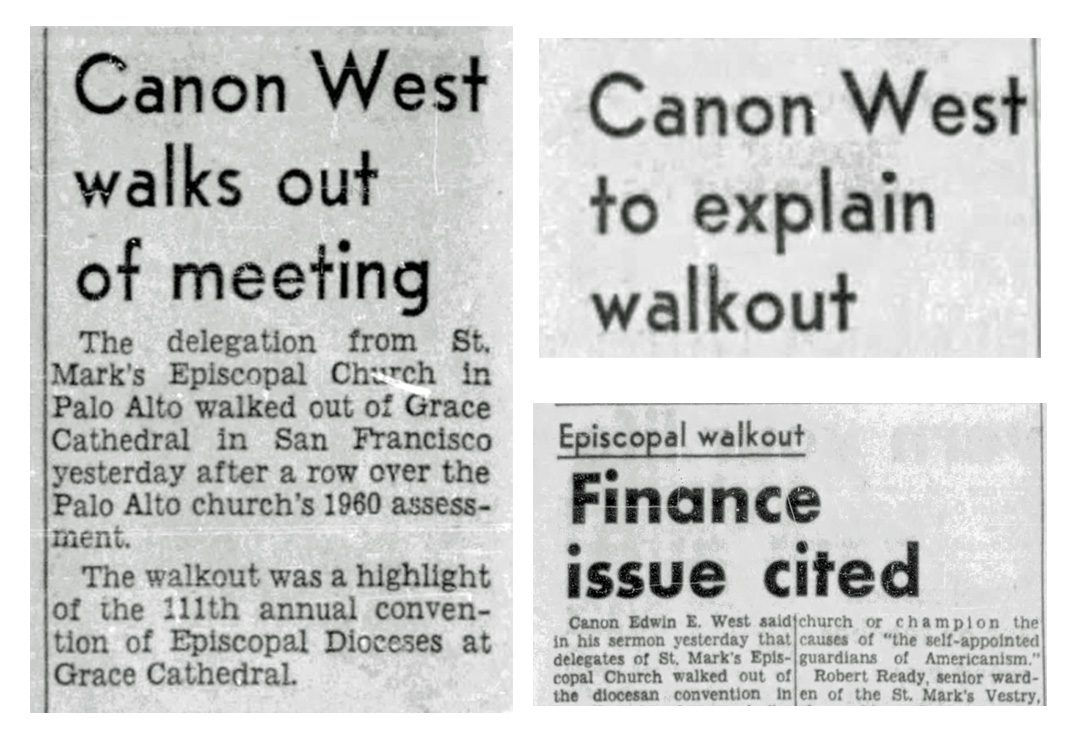Yes, you read that correctly. On Tuesday, January 31st, 1961, Canon West (then Rector of St. Mark’s) and the 12 member St. Mark’s convention delegation, walked out of the annual Diocesan Convention at Grace Cathedral in protest. The Palo Alto Times said the walkout was a highlight of the convention.
The dispute began when the St. Mark’s delegation noticed in a routine report that St. Mark’s was “classified as a ‘delinquent parish’ for not meeting its 1960 diocese assessment of $8,000.” (Palo Alto Times)
A diocesan assessment is a contribution (or some think of it as a kind of tax) that each parish makes to help fund the budget of the Diocese and all of its activities. In 2022, it’s a set percentage of the operating budget of each parish and is an amount set by the DIocese. That was not always the case in the past and that’s where the problem arose.

The walkout was led by West after an “exchange of words” took place on the convention floor between he and Bishop James Pike over the issue. The St. Mark’s delegation felt that there needed to be further negotiation about the assessment, and since that was not happening, they decided to walk out. When West got up and left, he was “followed out of the cathedral by the 12 members of his delegation.” West said “There was no acrimony. The last thing I said was ‘thank you for listening to me.’” (Palo Alto Times)
Bishop Pike seemed to disagree and commented that he had not “seen a walkout from a convention for a long time.” (Palo Alto Times)
Canon West went on to explain that he and the Vestry felt St. Mark’s assessment was “unjust because it was 60 percent higher than in previous years.” (Palo Alto Times)
He also encouraged people to come to St. Mark’s for either the 9 or 11 am Sunday service that coming week to hear a sermon he was giving “The Church’s True Strength” which would explain the entire issue. He promised that “My sermon will be a review of all the details leading to the present impasse.” (Palo Alto Times)
West said that St. Mark’s had asked for a formal hearing on the issue, and that they believed that “a democratic approach would be to have such a hearing so both sides can understand one another’s standpoint.” (Palo Alto Times)
West concluded by stating that “The church’s true strength lies in its firm convictions rather than in publicity or controversy. The church has enormous jobs and can’t afford to dissipate its strength in side issues.” (Palo Alto Times)

In his sermon on February 5th, Canon West explained that he hoped the walkout was “a gesture sufficiently grave to suggest the necessary reappraisal” by the diocese of the contested assessment. He also reiterated that, contrary to what many people were saying, this was purely a financial issue and had no connection with his having recently accused Bishop Pike of heresy. West said he was not trying to oust the Bishop of California or start his own church (stay tuned on more about that in a future article!).
In his sermon West explained that St. Mark’s had paid $8,600 to the diocese in 1960 and that the discrepancy was an additional $2,600 (and not $8,000 as reported at the convention). He claimed that in 1955 St. Mark’s had explained to the Diocese their plan for building and growing the parish and included a promise to “support the diocese on a gradually rising scale year by year.” This was a voluntary assessment based on the financial health and needs of the parish. He went on to note that from 1956-1960 increased annual assessments requested by the Diocese were accepted by St. Mark’s even “though they were higher than anticipated in the proposal of 1955.” (Palo Alto Times) In 1955, pledges to the diocese were optional. Over time, though, they became more compulsory, and the Diocese adopted a “stewardship” concept which included set percentages to support the planned Diocesan budgets. West said that two proposed Diocesan budgets for 1961 resulted in increases of either 67 or 127% in St. Mark’s annual assessment. The St. Mark’s vestry decided this was “clearly unjust and indeed impossible in view of debts and obligations.” (Palo Alto Times) The church claimed the rector and vestry had unsuccessfully sought to meet with diocesan authorities about the assessment issue for 14 months. In the meantime, they did not pay the full assessed amount for 1960, but a voluntary contribution they were comfortable with. Just before the convention, the Diocese notified St. Mark’s that they could remove their “delinquent” status by signing a promissory note to the Diocese for the balance due of the compulsory assessment. The Vestry believed this request meant that the diocese was unwilling to negotiate further about the amount of the assessment, and they were completely unwilling to sign such a note.
West concluded by saying that “the door remains open for intelligent discussion, and discussion must take place. We remain very much a parish of this diocese and very Episcopalian in our sympathies…our pledge of $17,000 for 1961 would indicate some mild interest at least.” (Palo Alto Times)
The senior warden, Robert Ready, went on to address parishioners that day and to reassure them that the Rector did act in line with positions endorsed by the Vestry.

The Vestry minutes of January of 1961 validate that the Bishop had written to the Parish about the 1960 assessment “delinquency” and that St. Mark’s refused to budge on the matter because they had not been granted a hearing with the Diocese. They wrote back to the Bishop and the Diocesan Council that month indicating that they did plan to pay the 1961 assessment in 12 equal installments. Interestingly, there are no Vestry minutes for February of 1961. In March of 1961, the minutes note that the wardens and rector were invited to meet with the Diocesan Council at the cathedral in April to discuss the disputed 1960 assessment. The upshot of this meeting was that nothing firm was decided, but that the Vestry felt that St. Mark’s would not have to pay the 1960 assessment balance (and they never did). Even more importantly, St. Mark’s was allowed to continue voluntary assessment contributions and was promised that if mandatory assessments were reinstated, Diocesan Officials were “better informed on some of the inequities that existed under past procedures” in relation to St. Mark’s and open to further discussion around the issue. (St. Mark’s Vestry Minutes)
So the dramatic walkout did seem to result in a win for St. Mark’s – although Canon West’s continued battles with Bishop Pike eventually led to his dramatic departure from St. Mark’s (that’s another story).
Diocesan assessments are currently compulsory in the Diocese of California and, although negotiable, are set by the Diocese. This issue does regularly come up and remains controversial. There are periodic discussions about the issue at Diocesan Conventions and Clergy Conferences, but maybe nothing as dramatic as the time Canon West and the entire St. Mark’s delegation stormed out of the cathedral in protest.



Did I miss it or does the above article not mention the percent of “income” St. Mark’s currently pays to the Diocese? (I put income in quotes because I believe the Diocesan tax is only on offerings/pledges?). It’s just that that information might be of import to us during Stewardship season? Sorry if I missed it. And I knew nothing of St. Mark’s at the time referenced in the article but I certainly knew of Bishop Pike and of his ultimate mysterious trek into oblivion. I actually find it comforting to recall that my generation thought we were tormented by the worst humanity had to offer. And yet, people got an education, went to war, fell in love, made babies or books or art and worked and died and fought injustice or created injustice or most of us simultaneously did both and yet prayed at whatever altar we thought best and here some of us still are and I don’t think we regret it and so you young whippersnappers of 50 or 40 or 4, you know, you will, too, you will, and don’t tell me the odds don’t look good, I imagine the odds looked way beyond impossible for those who flung themselves on the electrified fences of Sobibor and died on the spot while others ran—for freedom, for life, for love, for hope, for God. And those that ran into the Nazi-infested woods, they lived. And they lived fully. So please don’t get discouraged or inert. I mean, I get it. But take a peak at the Bible, folks. We’re kind of that way. So here’s a thought. Why don’t we put a few of our pieces of gold in offering pie plate and maybe we’ll all feel a tiny bit better, and you never know who will walk in the door of St. Mark’s next and feel a tiny bit better, too. I did. I walked in December 24, 1997’for the candlelight service. It was the first religious service I had ever attended and I was 50 years old and I felt a little bit better. So happy Stewardship—Indigenous People’s—Christ’s mass—your people’s/we the people’s mass and holidays, y’all. C’est tout! (Now what did I just do???!!! NOT. PLANNED. AT. ALL. AHAHAHA.)
Thank you, Jan. That was great. Actually in 1961 I was living in Boulder, Colorado, just married, but my family was here in Palo Alto and at St. Mark’s. I do recall all the broohaha about Canon West and Bishop Pike (who had confirmed me and my sister, Lyn). My mother, Flora Klay, was very devout and active at St. Mark’s and deeply troubled by the disputes by Pike and West. West finally left and started his own church in Los Altos but my family stayed at St. Mark’s. It was very “troubled times”. I do recall that Bishop Pike married a young woman and they left for a trip into the desert in some far away country and she was the only one to come out of the wilderness. He was never found. Very horrible & bizarre. Anna Klay